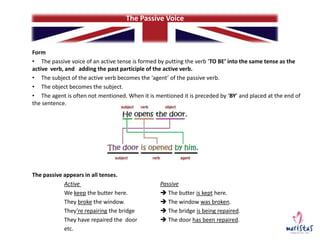
3ºeso_passive voice
- 1. Form • The passive voice of an active tense is formed by putting the verb ‘TO BE’ into the same tense as the active verb, and adding the past participle of the active verb. • The subject of the active verb becomes the ‘agent’ of the passive verb. • The object becomes the subject. • The agent is often not mentioned. When it is mentioned it is preceded by ‘BY’ and placed at the end of the sentence. The passive appears in all tenses. Active Passive We keep the butter here. The butter is kept here. They broke the window. The window was broken. They’re repairing the bridge The bridge is being repaired. They have repaired the door The door has been repaired. etc. The Passive Voice
- 2. Auxiliary / Modal + Infinitive combinations are made passive by using a passive infinitive. E.g. You must shut these doors. These doors must be shut. Active tenses and their passive equivalents: The Passive Voice Tense/Verb form Active voice Passive voice Simple present keeps is kept Present continuous is keeping is being kept Simple past kept was kept Past continuous was keeping was being kept Present perfect has kept has been kept Past perfect had kept had been kept Future will keep will be kept
- 3. In colloquial speech ‘GET’ is sometimes used instead of ‘BE’. E.g. The eggs got broken. You’ll get sacked if you take any more time off. A sentence containing a direct and an indirect object could have two passive forms: E.g. Someone gave her a bulldog A bulldog was given to* her. (*to is necessary) She was given a bulldog. (most common form) When a verb + preposition + object combination is put into the passive, the preposition will remain immediately after the verb. E.g. We must write to him He must be written to. Use: In English the passive is used more than in Spanish. • When it’s not necessary to mention the doer of the action, as it is obvious or E.g. The streets are swept everyday. • When we don’t know who did the action E.g. The minister was murdered. • When you are more interested in the action than the subject. E.g. The house next door has been bought. (By Mr. Jones) • When the subject would be ‘PEOPLE’ or ‘ONE’. E.g. They are supposed to be living in New York. (By people in general) • For stylistic reasons (not to repeat a subject). The Passive Voice
- 4. The Passive Voice Rewrite the sentences in passive voice. 1. John collects money. - 2. Anna opened the window. - 3. We have done our homework. - 4. I can answer the question. - 5. I will ask a question. - 6. The sheep ate a lot. - 7. I am answering the question- 8. William has repaired the car. - 9. Did Sue draw this circle? - 10. Could you feed the dog? – 2 objects: Rachel will give you some advice. → I sent him a letter. → The police officer showed us the way. → Our neighbour gave me a lift.